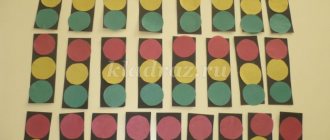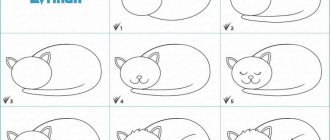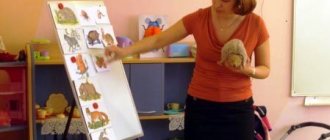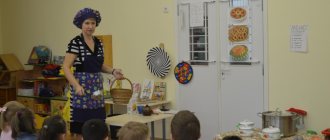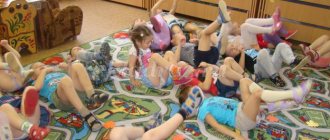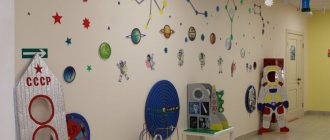Preview:
Drawing lesson for the middle group.
Theme "Beautiful napkins"
Goal: To teach children to decorate round napkins with patterns.
Children's goal: help Katya doll decorate the table for tea drinking.
Introduce children to the concept of “pattern”.
Show options for combining decorative elements by color and shape (dots, circles, spots, lines)
Develop a sense of color and rhythm in children.
Cultivate interest in folk arts and crafts.
1.Introduction to the game situation:
- Guys, we have guests today. These are parents, educators. Look at them, smile, wave.
- Now look at me. Eyes and ears are tuned, I’ll ask you about something interesting. Tell me please, do you like to visit?
- Today is Katya's doll's birthday, and she invites everyone to a tea party. What is tea drinking? Well done. Do you want to go visit her?
Approach the table on which there is a pre-made service set. Dolls are sitting on the sofas. Children stand around the corner.
Vosp.: Hello, Katya!
Katya: Hello children!
Vosp.: How elegant you are today, and what a wonderful table you have! Look kids, do you recognize it? Our set, which we sculpted as a gift for Katya.
Katya: Thank you guys, the service is wonderful. Very suitable for the holiday table.
Vosp.: Katya, where are the napkins on your table? Guys, isn’t it customary for us to set the table with beautiful napkins and towels? Do all mothers and grandmothers do this? To make it beautiful and festive?
Katya: Oh-oh, guys. I completely forgot about the napkins. I took them to wash and forgot about them. What to do?
Play: Children, you need to help Katya make beautiful, festive, painted napkins. Want to?
Katya: Oh, guys, can you?
Vosp.: Then you, Katya, sit with the guests for now, and the guys and I will give you another gift.
2. Visual activity.
- Guys, come to the tables and take your seats.
- I would like to invite you to paint your napkins with beautiful patterns.
- Guys, do you know what a pattern is?
- A pattern is the decoration of something with lines, dots, or circles. And this decoration creates a whole picture on napkins and towels. Which makes it very pleasant to look at them and makes the food taste better at the table. Want to see what patterns there are?
(remove the screen from the easel with samples)
- Guys, look, I think we can handle this pattern. Shall we try? (remove other patterns)
“Then prepare your ears so you don’t listen to anything, and your eyes so you don’t miss anything.” (Remove the sample, attach a blank circle)
- Let's take some brushes. Does everyone remember that we hold the brush with three fingers near the “piece of iron”?
- Now let's take yellow paint and draw a circle in the middle of our napkin, the size of a small tangerine. The circle should be filled inside. (Draw on the sample)
- Whoever drew the circle, rinse the brush thoroughly and wipe it with a cloth so that it is dry.
- Now we take green paint and paint around our yellow circle to make these green patterns. (Show on sample)
Go and see how it turns out. Individually help/give advice to those who cannot cope.
- Now put the brushes on rags. They won't be needed anymore. (Collect brushes and water)
- Now look what I have. What is this? (cotton swab)
- Do you think you can draw with a cotton swab?
- There is even a way to draw like this. Dots. Let's try. To do this, you need to take a little red paint with a stick and put dots along the edge of our napkin. Look how beautiful it turned out.
- Now you try it. (Hand out sticks)
- And now, to complete our beautiful pattern, you can put one dot in the middle of the yellow circle.
- Whoever has done everything, put the chopsticks on a cloth. Take your beautiful napkin and bring it here to the exhibition. (Oval table). Then take a damp napkin, wipe the handles and you can admire our patterns.
(quickly help the other children, take the Katya doll and bring it to the table, call all the children)
Vosp: Katya, look at what beautiful napkins we painted for you!
Katya: Children, what great fellows you are! You did so great! Now tea drinking will become even more beautiful and tastier! Thank you guys!
Vosp: Katya, go to the guests for now! Guys, I want to invite you to the carpet.
- Tell me, who did we help today?
- How could we help Katya?
- Why do you think we succeeded? (because we know how to draw patterns)
- Well done! You've done it. You can go play.
Notes on drawing in the middle group “Teddy Bear”
Goal : to make children want to draw a bear using a stencil (outline), learn to paint along the contour using the “poke” method, consolidate knowledge of color (brown), and instill interest in drawing in different ways.
Materials: a sample of a finished drawing of a bear, an outline of a bear on a landscape sheet, a toy - a large brown bear, stencils, bristle brushes No. 4, thin soft brushes, a simple pencil, gouache (brown, black), napkins.
Progress of the lesson:
1. Organizational moment, problematic situation.
- Guys, it seems like someone is crying, can you hear it in the doll corner?
-Who is crying here? (Bear). Yes, this is Mishka the clubfooted one.
- How did you end up here, Mishka, and why are you crying? (The teacher voices the toy.)
- I came to you from the forest. Winter will come soon and I need to go to bed in the den.
“And why did this upset you so much?” After all, all bears sleep in their dens in winter. They feel warm and cozy there in winter.
- Yes it is. I already wanted to lie down in my den for the whole winter, but I remembered that I have no friends, I am so alone. And I felt very, very sad (crying).
- Don't cry, Mishka! You are so beautiful, fluffy, shaggy, calm down (Bear is crying).
- Oh, guys, what should we do? How can we cheer up Mishka? We need to help him find friends. But how? (Children's answers.)
- Can you draw it?
- Calm down, Mishka, don’t be sad, we will help you find friends as beautiful as you.
- Let's go to the tables (everything you need is there).
I have a friend in my hands for our Teddy Bear (show a sample and turn to the toy).
- Look, Mishka, you will have many such beautiful and kind friends.
2. Main part.
— Today we will draw a bear using a stencil. You have stencils of bears on your tables, they are all different: some have a bear standing, some have a bear dancing, some have a bear doing exercises. We will draw different friends for Mishka. To do this, you need to put the stencil on a sheet of paper and trace along the outline with a pencil.
- First, take the stencil in your hand and trace it with your finger. Like this. And then we will color the Bear, and we will do it in a new way. To depict the bear as fluffy, we will use a bristle brush. The brush will work in a special way: it will jump up and down. Take the brushes in your hands and try them without paint (show how the brush will work).
- Well done, you are doing everything right! We start coloring from the head. Look, I'm picking up paint. What color paint do we need to paint the bear? (Brown.)
— I pick up some brown paint and start drawing along the contour. I will go around the entire outline using the “poke” method, then I will paint over the entire bear using the same method. My brush is jumping up and down. The result was a beautiful, fluffy bear. But what did I forget to draw? (Eyes, mouth, nose.) To draw the eyes, mouth, nose, I will take a thin brush, dip it in black paint and paint with the end of the brush. What is my bear's mood?
3. Physical education minute: “Two bears were sitting…”
4. Independent activity of children.
- And now you will each draw your own bear. What kind of bears will you have - happy or sad?
5. Summing up.
Analysis: (I take a toy) Bear, look how many friends you have now! The kids tried so hard to help you. Now you can sleep peacefully in your den.
- Thank you, guys, I like this funny little bear, and this funny one, and I really like them all and now I have a lot of friends! Hooray! Goodbye!
- But before you leave, play with us (the game “Bear-toed Bear”).
- Thank you for staying with us to play. And now it's time for you to go into the forest, goodbye.
On the topic: methodological developments, presentations and notes
There on unknown paths Goal: .
To expand children's knowledge and understanding of the features of the appearance of a goldfish. Introduce an excerpt from “The Tale of the Goldfish” by A. S. Pushkin.
Teach children to respond to the poetry of A. S. Pushkin’s poetic lines.
Target. Learn to convey your impression of the autumn beauty of nature. Develop artistic and creative abilities.
Target. Continue to form an emotional response to the work of art.
Goal: Learn to draw horizontal lines, consolidate the ability to hold a brush correctly, consolidate colors: blue and red, cultivate aesthetic feelings. Vocabulary work: Horizontal lines, long.
summary of a drawing lesson in the middle group.
Source
Progress of the lesson:
Children are standing on the carpet.
Educator: “Guys, today is Katya’s doll’s birthday . Look how elegant she is, guests have already come to see her toys, and how many treats have been prepared! Listen to what Katya tells us (The teacher speaks on behalf of Katya: “Guys, I invite everyone to my birthday . We will drink tea and have fun”)
Educator: -And I will help Katyusha. Guys, take the cups, there is hot tea in the samovar. (children approach the tables, take cups, suddenly Doll Katya starts crying)
Educator: -What happened, Katyusha?
Katya: -I so wanted it to be beautiful, so that everyone would have a cup and a napkin , but I forgot to prepare them. Oh, what to do now?
Educator: -Yes, what to do, how to help Katya?
Children: - We will draw napkins .
Educator: -Calm down, Katya, the children will draw beautiful napkins and give them to you . Really, guys?
Educator: -I have this napkin . Do you like her?
Educator: - Would you like me to teach you how to draw (children’s answers)
Let the toys sit for now. And we will sit down at our tables. We'll take Katya too.
- First, I draw a circle like this of the napkin What colour is he? Then I paint it over as I see fit. I don't need yellow paint anymore. I wash my brush and blot it on a napkin . Now I draw the petals. What color are they? (orange)
. – They don’t touch the circle. The brush follows the hand all the time. Watch my hand carefully. Draw from the middle to the edges. First down, then up, left - this is the most difficult stroke, and right. Now we draw between the petals. So what's now?
Children: - wash and dry the brush.
Educator: -What else is left to draw ?
Educator: - Correct. This is the border. I draw it slightly backing from the edge, at the same distance from it, tearing the brush off the napkin . The strokes turn out to be slightly curved, all the same, we alternate them with dots: stroke, dot, etc. I don’t turn the napkin . Only the position of the arm and hand changes. The napkin is ready .
(The teacher pronounces the text and performs the movements, and the children imitate him, finishing words and phrases)
Outdoor game "Dress"
This dress is for Natasha -
(Four rhythmic turns left and right, hands on the belt.)
(Four rhythmic jumps on both legs.)
And the dress has two pockets,
("Drawing"
There are two pockets on the tummy.)
Let's hide our palms in them.
(Place both palms on your tummy)
- What a great fellow you are, you have warmed up well, now you children, get to work. The dolls are waiting for you , they really want to continue the fun. Try to make Katyusha like your gifts . She will look at you, and while the toys listen to music, music will help you in your work. (I turn on a recording with calm music)
While working, make sure that children use
a napkin and water correctly. I help you find the middle and draw a circle . Helping the children use the technique of repeated showing and conjugate drawing . During independent work, I take the doll and walk with it , evaluating the work on Katya’s behalf.
(What a smooth middle you have, and your brush is so neat, because you washed and blotted the brush well) Offer the first child to complete the work to take Katya and watch how the children paint. When most of the children have completed the task, I suggest going out onto the carpet, holding the finished napkins , and showing them to the dolls . The doll Katya thanks the children.
Educator: - Guys, now Katya invites you to drink tea. (Children take cups, pour tea, treat dolls and bears)
Educator: - That's how much fun we have. That's how happy Katya is. It's because you did a good job.
Notes for a lesson in the second junior group “Multi-colored lights” Notes for a lesson on sensory education in the second junior group “Multi-colored lights” Program tasks. Strengthen the ability to highlight.
Video lesson “Fun Fair in Dymkovo” Program content: Learn to draw a pattern for the skirt of a Dymkovo doll from stripes, rings, in combination with small elements: dots, circles.
Source
On the topic: methodological developments, presentations and notes
Topic: Let's decorate aprons for March 8th with a Tatar pattern Educational areas: artistic creativity, socialization, communication, music Type: harmonious development of children by means of art.
An open integrated lesson for artistic, aesthetic and cognitive development.
WILD ANIMALS. BEAUTIFUL NAPKIN Purpose: to develop the ability to recognize, name and distinguish the features of the appearance and lifestyle of wild animals; cultivate activity, independence, love.
"Beautiful napkins for Katya's doll."
Educational objectives: learn to create an image - a symbol of the Chuvash pattern depicting the sun, arranging the elements of the pattern and gluing them to the base. Developmental objectives: develop children's ability to place.
Summary of GCD in the junior group on artistic and aesthetic activities. “Let's decorate a napkin with a pattern.” Educator of the 1st category Novikova S.P. Tasks.-To consolidate with children the ability to draw mountains.
Source
